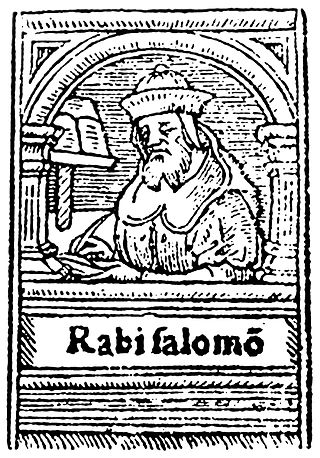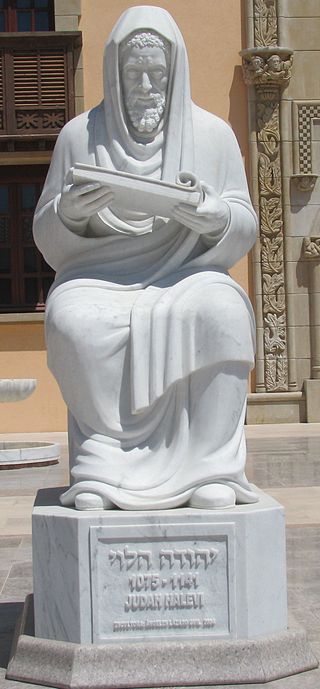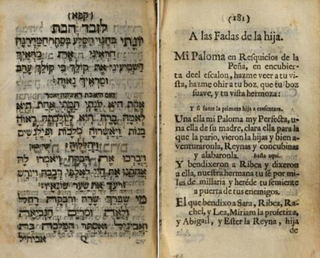Related Research Articles

Shlomo Yitzchaki, generally known by the acronym Rashi, was a medieval French rabbi, the author of comprehensive commentaries on the Talmud and Hebrew Bible.

Rabbinic literature, in its broadest sense, is the entire spectrum of rabbinic writings throughout Jewish history. However, the term often refers specifically to literature from the Talmudic era, as opposed to medieval and modern rabbinic writing, and thus corresponds with the Hebrew term Sifrut Chazal. This more specific sense of "Rabbinic literature"—referring to the Talmudim, Midrash, and related writings, but hardly ever to later texts—is how the term is generally intended when used in contemporary academic writing. The terms mefareshim and parshanim (commentaries/commentators) almost always refer to later, post-Talmudic writers of rabbinic glosses on Biblical and Talmudic texts.
Levites or Levi are Jewish males who claim patrilineal descent from the Tribe of Levi. The Tribe of Levi descended from Levi, the third son of Jacob and Leah. The surname Halevi, which consists of the Hebrew definite article "ה" Ha- ("the") plus Levi (Levite) is not conclusive regarding being a Levite; a titular use of HaLevi indicates being a Levite. The daughter of a Levite is a "Bat Levi".

Judah Halevi was a Spanish Jewish physician, poet and philosopher. He was born in Spain, either in Toledo or Tudela, in 1075 or 1086, and died shortly after arriving in the Holy Land in 1141, at that point the Crusader Kingdom of Jerusalem.

Dunash ha-Levi ben Labrat was a medieval Jewish commentator, poet, and grammarian of the Golden age of Jewish culture in Spain. He is known for his philological commentary, Teshuvot Dunash, and for his liturgical poems D'ror Yiqra and D'vai Haser.

Zeved habat or Simchat Bat is the Jewish naming ceremony for newborn girls. The details of the celebration varies somewhat by Jewish community and will typically feature the recitation of specific biblical verses and a prayer to announce the name of the newborn child.
Rishonim were the leading rabbis and poskim who lived approximately during the 11th to 15th centuries, in the era before the writing of the Shulchan Aruch and following the Geonim. Rabbinic scholars subsequent to the Shulchan Aruch are generally known as acharonim.
Aharon ben Joseph haLevi, known by his Hebrew acronym Ra'aH, was a medieval rabbi, Talmudic scholar and Halakhist.
Samuel ibn Naghrillah, also known as Samuel HaNagid and Isma’il ibn Naghrilla, was a medieval Jewish Spanish Talmudic scholar, grammarian, philologist, soldier, merchant, politician, and an influential poet who lived in Iberia at the time of the Moorish rule. His poetry was one area through which he was well known. He was perhaps the most politically influential Jew in Muslim Spain. He was also the Prime Minister of the Muslim state of Granada and battlefield commander of the non-Jewish Granadan army.
Bostanai, also transliterated as Bustenai or Bustnay, was the first Exilarch under Arab rule. He lived in the early-to-middle of the 7th century, and died about 660 CE. The name is Aramaized from the Persian bustan or bostan, meaning "Garden". Bostanai is the only Dark Age Babylonian Exilarch of whom anything more than a footnote is known. He is frequently made the subject of Jewish legends.

Jewish literature includes works written by Jews on Jewish themes, literary works written in Jewish languages on various themes, and literary works in any language written by Jewish writers. Ancient Jewish literature includes Biblical literature and rabbinic literature. Medieval Jewish literature includes not only rabbinic literature but also ethical literature, philosophical literature, mystical literature, various other forms of prose including history and fiction, and various forms of poetry of both religious and secular varieties. The production of Jewish literature has flowered with the modern emergence of secular Jewish culture. Modern Jewish literature has included Yiddish literature, Judeo-Tat literature, Ladino literature, Hebrew literature, and Jewish American literature.
Simḥa ben Samuel of Speyer was a German rabbi and tosafist. Neither the year of his birth nor that of his death is known. He was one of the leading signatories of the Takkanot Shum He was a nephew of the director (parnas) Kalonymus, a student of R. Eliezer of Metz, and a colleague of Eliezer ben Joel ha-Levi.
The primary texts of Kabbalah were allegedly once part of an ongoing oral tradition. The written texts are obscure and difficult for readers who are unfamiliar with Jewish spirituality which assumes extensive knowledge of the Tanakh, Midrash and halakha.
Rashi's daughters were the three daughters and only children of the medieval Talmudic scholar, Rashi and his wife Rivka. Their three daughters were Yocheved, Miriam and Rachel. They each married their father's finest students and were the mothers of the leaders of the next generation of French Talmudic scholars. Almost every Ashkenazi rabbinic dynasty traces its ancestry back to either Yocheved or Miriam, and the majority of the tosafists, were recent descendants of Rashi's daughters. All born in Troyes, France, their descendants inhabited Germany, France, and Italy in the early 11th to 15th centuries, with the majority later moving to Eastern Europe, where they established several notable rabbinic dynasties.
Sura Academy was a Jewish yeshiva located in Sura in what is now southern Iraq, a region known in Jewish texts as "Babylonia". With Pumbedita Academy, it was one of the two major Jewish academies from the year 225 CE at the beginning of the era of the Amora sages until 1033 CE at the end of the era of the Gaonim. Sura Academy was founded by the Amora Abba Arikha ("Rav"), a disciple of Judah ha-Nasi. Among the well-known sages that headed the yeshiva were Rav Huna, Rav Chisda, Rav Ashi, Yehudai ben Nahman, Natronai ben Hilai, Saadia Gaon, and others.
A bat-kohen or bat kohen is the daughter of a kohen, who holds a special status in the Hebrew Bible and rabbinical texts. She is entitled to a number of rights and is encouraged to abide by specified requirements, for example, entitlement to consume some of the priestly gifts, and an increased value for her ketubah.
Samuel ben Ali ha-Levi was the most noteworthy of the twelfth-century Babylonian scholars and the only one of his era whose written works have survived in any significant number.
Rabbi Samuel ben Natronai also known as RaSHBaT was a 12th-century German Tosafist.
References
- Baskin, J. R. (2012). Educating Jewish Girls in Medieval Muslim and Christian Settings. Making a Difference: Essays on the Bible and Judaism in Honor of Tamara Cohen Eskenazi. Sheffield: Sheffield Phoenix, 19-37.
- Emily Taitz, Sondra Henry & Cheryl Tallan, The JPS Guide to Jewish Women: 600 B.C.E.to 1900 C.E. , 2003
- https://jwa.org/encyclopedia/article/learned-women-in-traditional-jewish-society
